Everyday Mathematics 1st Grade Answer Key Unit 5 Place Value Comparisons
Everyday Mathematics Grade 1 Home Link 5.1 Answers
Introducing Place Value
Family Note
Today your child learned about place value using base-10 blocks. In the charts below, the blocks in the Tens box are called longs, and the blocks in the Ones box are called cubes. Ten cubes is the same as one long. Base-10 blocks are used throughout Everyday Mathematics to represent multidigit numbers.
Example:

What number am I? 28
Question 1.
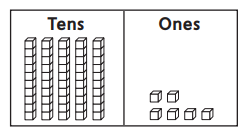 What number am I? _________
What number am I? _________
Answer:
I am Number = 56 or Fifty Six.
Explanation:

Number of longs in Tens box = 5 × 10 = 50 or Fifty
Number of blocks in the Ones box = 6 or Six.
Number I am= Number of longs in Tens box + Number of blocks in the Ones box
= 50 + 6
= 56 or Fifty Six.
Question 2.
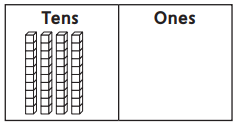 What number am I? _________
What number am I? _________
Answer:
I am Number = 40 or Forty.
Explanation:

Number of longs in Tens box = 5 × 10 = 40 or Forty.
Number of blocks in the Ones box = 0 or Zero.
Number I am= Number of longs in Tens box + Number of blocks in the Ones box
= 40 + 0
= 40 or Forty.
Question 3.
 What number am I? _________
What number am I? _________
Answer:
I am Number = 12 or Twelve.
Explanation:

Number of longs in Tens box = 1 × 10 = 10 or Ten.
Number of blocks in the Ones box = 2 or Two.
Number I am= Number of longs in Tens box + Number of blocks in the Ones box
= 10 + 2
= 12 or Twelve.
Practice
Question 4.
Use a pencil to measure a large box.
How tall is the box? About ________ pencils
Answer:
2 or Two pencils tall is the my dad’s laptop cardboard box.
Explanation:
I am measuring is my dad’s laptop cardboard box.
Height of my dad’s laptop cardboard box = 2 pencils.
Everyday Math Grade 1 Home Link 5.2 Answer Key
Digits and Place Value
Family Note
Today your child explored place value using calculators and number grids. Children used a calculator to see how digits change as we count, specifically when we count from 9 to 10, 39 to 40, and so on. Then children used a number grid to observe the relationship between numbers that have the same digit in the tens place or the same digit in the ones place.
IMPORTANT: Please send at least 5 dimes to class with your child tomorrow. Your child will continue exploring place value using pennies and dimes tomorrow.
Question 1.
List 5 numbers with 6 in the tens place.
Answer:
669 , 963 , 65 , 165 , 260 are 5 or Five numbers having 6 in the tens place.
Explanation:
5 or Five numbers with 6 in the tens place are:
669 , 963 , 65 , 165 , 260.
Question 2.
List 5 numbers with 8 in the ones place.
Answer:
8 , 28 , 568 , 408 , 788 numbers with 8 in the ones place.
Explanation:
8 or Eight numbers with 8 in the tens place are:
8 , 28 , 568 , 408 , 788.
Practice
Question 3.
Oliver and Olivia each have 4 rings. How many rings do they have in all?
_________ rings
Number model: ___________
Answer:
Total number of rings both have in all = 8 or Eight.
Number model: 4 + 4 = 8 or Eight.
Explanation:
Number of rings Oliver has = 4 or Four.
Number of rings Olivia has = 4 or Four.
Total number of rings both have in all = Number of rings Oliver has + Number of rings Olivia has
= 4 + 4
= 8 or Eight.
Everyday Mathematics Grade 1 Home Link 5.3 Answers
Pennies, Dimes, and Place Value
Family Note
Coins provide a great real-world context for practicing place value. Today your child practiced exchanging ones and tens using pennies and dimes. Since counting money is an important everyday skill, you may want to practice counting and exchanging coins at home.

Question 1.
![]() is the same as __________
is the same as __________ ![]() and _________
and _________ ![]() .
.
This is _________ cents.
Answer:
 is the same as __1________
is the same as __1________ ![]() and ____0_____
and ____0_____ ![]() .
.
This is ____10 or Ten____ cents.
Explanation:
Number of ![]() given = 10 or Ten.
given = 10 or Ten.
Cost of the each ![]() given = 1 cent
given = 1 cent
Total cost of of the ![]() given = Number of
given = Number of ![]() given × Cost of the each
given × Cost of the each ![]() given
given
= 10 × 1 cent
= 10 or Ten cents.
Question 2.
![]() is the same as __________
is the same as __________ ![]() and _________
and _________ ![]() .
.
This is _________ cents.
Answer:
 is the same as __1________
is the same as __1________ ![]() and ____2_____
and ____2_____ ![]() .
.
This is __12 or Twelve_______ cents.
Explanation:
Number of ![]() given = 12 or Twelve.
given = 12 or Twelve.
Cost of the each ![]() given = 1 cent
given = 1 cent
Total cost of of the ![]() given = Number of
given = Number of ![]() given × Cost of the each
given × Cost of the each ![]() given
given
= 12 × 1 cent
= 12 or Twelve cents.
Question 3.
![]()
![]()
![]() is the same as __________
is the same as __________ ![]() and _________
and _________ ![]() .
.
This is _________ cents.
Answer:
 is the same as ___2_______
is the same as ___2_______ ![]() and ___1______
and ___1______ ![]() .
.
This is __21 or Twenty One_______ cents.
Explanation:
Number of ![]() given = 21 or Twenty One.
given = 21 or Twenty One.
Cost of the each ![]() given = 1 cent
given = 1 cent
Total cost of of the ![]() given = Number of
given = Number of ![]() given × Cost of the each
given × Cost of the each ![]() given
given
= 21 × 1 cent
= 21 or Twenty One cents.
Practice
Question 4.
How many spoons are in your kitchen? ___________ spoons
Answer:
In our Kitchen, we have 54 or Fifty Four spoons.
Explanation:
In our Kitchen, we have 54 or Fifty Four spoons.
Everyday Math Grade 1 Home Link 5.4 Answer Key
Relation Symbols
Family Note
Today your child was introduced to the relation symbols < and >. The < means “is less than,” and the > means “is more than.” These symbols are used in the same way = is used to mean “is equal to” or “is the same amount as.” For example, instead of writing 5 is less than 8, we write 5 < 8.
It takes time for children to learn how to correctly use these symbols. One way to help your child identify the correct symbol is to draw two dots near the larger number and one dot near the smaller number. Then connect the dots as shown below.
![]()
Another way is to think of the open end of the symbol as a mouth eating the larger number.

Question 1.
Write <, >, or =.
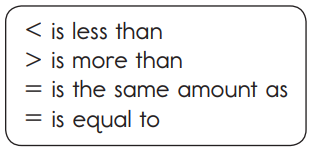
Example: 18 > 12
11 ______ 7
21 ______ 25
37 ______ 37
29 ______ 42
35 ______ 15
48 ______ 78
Answer:
11 __>____ 7.
21 __<____ 25.
37 __=____ 37.
29 ___<___ 42.
35 ___>___ 15.
48 __<____ 78.
Explanation:

11 __>____ 7.
21 __<____ 25.
37 __=____ 37.
29 ___<___ 42.
35 ___>___ 15.
48 __<____ 78.
Practice
Question 2.
Talia has 8 red leaves. Jon has 9 yellow leaves. How many leaves do they have in all? ________ leaves
Number model: ____________
Answer:
Total number of leaves they have in all = 17 or Seventeen.
Number model: = 8 + 9 = 17 or Seventeen.
Explanation:
Number of Red leaves Talia has = 8 or Eight.
Number of Yellow leaves Jon has = 9 or Nine.
Total number of leaves they have in all = Number of Red leaves Talia has + Number of Yellow leaves Jon has
= 8 + 9
= 17 or Seventeen.
Everyday Mathematics Grade 1 Home Link 5.5 Answers
The Equal Sign
Family Note
Today your child continued practicing addition and subtraction and working with the equal sign as he or she determined whether number sentences were true or false. Your child also changed numbers and symbols (+, -, =, <, >) to make number sentences true.
Question 1.
Write True or False next to each number sentence.
10 = 7 + 2 __________
4 + 4 = 3 + 5 __________
10 – 5 = 0 + 5 __________
3 + 9 = 9 + 3 __________
14 – 7 = 8 __________
7 = 7 __________
4 + 0 = 3 – 1 __________
Answer:
10 = 7 + 2 __False________.
4 + 4 = 3 + 5 ___True_______.
10 – 5 = 0 + 5 ___True_______.
3 + 9 = 9 + 3 __True________.
14 – 7 = 8 ___False_______.
7 = 7 __True________.
4 + 0 = 3 – 1 ___False_______.
Explanation:
Write True or False.
10 = 7 + 2
=> 10 = 9 (False).
4 + 4 = 3 + 5
=> 8 = 8 (True).
10 – 5 = 0 + 5
=> 5 = 5 ( True ).
3 + 9 = 9 + 3
=> 12 = 12 ( True ).
14 – 7 = 8
=> 7 = 8 ( False).
7 = 7 ( True ).
4 + 0 = 3 – 1
=> 4 = 2 ( False).
Practice
Question 2.
Circle the tens digit in each number.
3 1
9 4
1 7
Answer:

Explanation:
The Tens place in 31 = 3 or Three.
The Tens place in 94 = 9 or Nine.
The Tens place in 17 = 1 or One.
Everyday Math Grade 1 Home Link 5.6 Answer Key
Number Scrolls
Family Note
Today your child used knowledge of place value to fill in number grids and then construct number scrolls. Ordering numbers on a grid helps children identify number patterns and develop number sense. Talk with your child about patterns in the number grid shown below.
Question 1.
Tell someone at home how you filled in number grids to make a number scroll.
Answer:
I shared my experience of understanding numbers and their patterns with my parents. Number grids means numbers in order of one above the other. whereas number scroll means understanding the pattern of their difference in them which is common in the given list of numbers.
Explanation:
Number grids can be used to explore number patterns.
A number scroll is a method for practicing numbers and recognizing patterns. The students will complete charts that have been taped together to create a long scroll of numbers.
Question 2.
Ask about any other kinds of scrolls that person knows.
Answer:
My parents said me about the pattern of number scroll in the clock. The pattern of minutes in the clock is of 5 minutes.
Explanation:
My parents said me about the pattern of number scroll in the clock. The pattern of minutes in the clock is of 5 minutes. That was very interesting to know.
Question 3.
Show that person how to fill in the bottom 3 rows of this number grid.
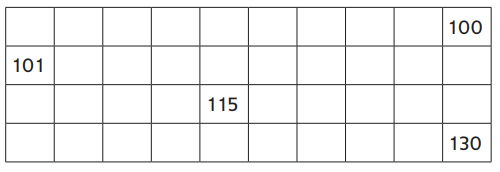
Answer:
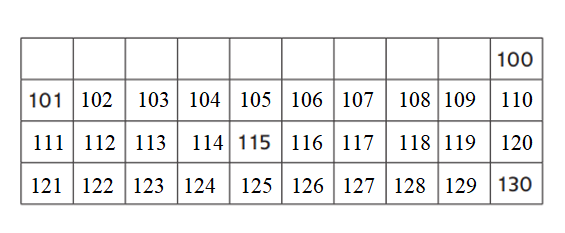
Explanation:
Here, in the above chart the numbers pattern is one greater than the previous number.

Practice
Question 4.
Solve.
2 + 4 = __________
__________ = 10 – 3
4 + __________ = 10
Answer:
2 + 4 = __6 or Six. ________
_7 or Seven __ = 10 – 3
4 + __ 6 or Six.___ = 10
Explanation:
2 + 4 = 6 or Six.
7 or Seven = 10 – 3
4 + __________ = 10
=> 4 + ?? = 10
=> ?? = 10 – 4
=> ?? = 6 or Six.
Everyday Mathematics Grade 1 Home Link 5.7 Answers
Measuring Crooked Paths
Family Note
Today your child learned to measure the length of a crooked path. Children found that the length of a path is the same whether they measure the whole path at once or measure each of its parts and add the lengths together. This understanding will help children measure more complex paths.
Question 1.
Use one paper clip to measure the length of this path. Write a number model to show adding the parts of the path

This path is __________ paper clips long.
Number model: _____________
Answer:
Total length of the path = 4 or Four paperclips.
Number model: 1 paperclip + 1 paperclip + 1 paperclip + 1 paperclip = 4 or Four paperclips.
Explanation:
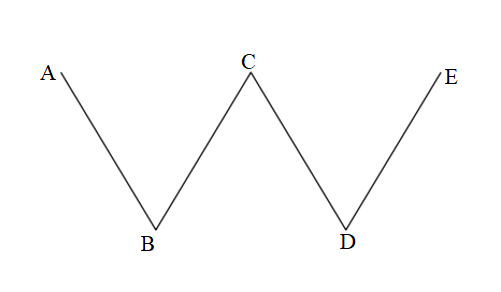
Length of AB path = 1 paperclip
Length of BC path = 1 paperclip
Length of CD path = 1 paperclip
Length of DE path = 1 paperclip
Total length of the path = Length of AB path + Length of BC path + Length of CD path + Length of DE path
= 1 paperclip + 1 paperclip + 1 paperclip + 1 paperclip
= 2 paperclip+ 1 paperclip + 1 paperclip
= 3 paperclip + 1 paperclip
= 4 or Four paperclips.
Practice
What numbers do the base-10 blocks show?
Question 2.

__________
Answer:
Number = 63 or Sixty Three.
Explanation:

Number of longs given = 6 or Six = 6 × 10 = 60 or Sixty.
Number of blocks given = 3 or Three = 3 × 1 = 3 or Three.
Number = Number of longs given + Number of blocks given
= 60 + 3
= 63 or Sixty Three.
Question 3.

__________
Answer:
Number = 19 or Nineteen.
Explanation:
Number of longs given = 1 or One = 1 × 10 = 10 or Ten.
Number of blocks given = 9 or Nine = 9 × 1 = 9 or Nine.
Number = Number of longs given + Number of blocks given
= 10 + 9
= 19 or Nineteen.
Question 4.
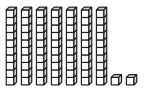
__________
Answer:
Number = 72 or Seventy Two.
Explanation:
Number of longs given = 1 or One = 7 or Seven = 7 × 10 = 70 or Seventy.
Number of blocks given = 2 or Two = 2 × 1 = 2 or Two.
Number = Number of longs given + Number of blocks given
= 70 + 2
= 72 or Seventy Two.
Everyday Math Grade 1 Home Link 5.8 Answer Key
Explorations and Exchanges
Family Note
Today your child learned a game involving exchanges with base-10 blocks and explored comparing and measuring length. Have your child tell you about the Explorations that the class did today.
Question 1.
This is one way to show the number 21 with base-10 blocks.
| ▪ ▪ ▪ ▪ ▪ ▪ ▪ ▪ ▪ ▪ ▪
Use | and ▪ to show 21 in two other ways.
Answer:
Two other ways to show 21 are:
|| ▪
▪▪▪▪▪▪▪▪▪▪▪▪▪▪▪▪▪▪▪▪▪
Explanation:
First way to show 21 :
|| ▪
Second way to show 21 :
▪▪▪▪▪▪▪▪▪▪▪▪▪▪▪▪▪▪▪▪▪
Practice
Question 2.
Use a fork to measure. How many forks wide is your kitchen sink?
_________ forks
Answer:
Length of my kitchen sink wide = 4 forks.
Explanation:
Length of my kitchen sink wide = 4 forks.
Everyday Mathematics Grade 1 Home Link 5.9 Answers
More Comparison Symbols
Family Note
Today your child practiced using relation symbols <, >, and = to model number stories about the weights of various animals.
Question 1.
Fill in the blank with <, >, or =.
12 _________ 11
13 + 20 _________ 31
28 _________ 19 + 10
15 _________ 9 + 6
7 _________ 17
45 _________ 45
17 + 3 _________ 22
40 _________ 20 + 0
Answer:
12 ___>______ 11.
13 + 20 _____>____ 31.
28 ___<______ 19 + 10.
15 __=_______ 9 + 6.
7 ___<______ 17.
45 ____=_____ 45.
17 + 3 ___<______ 22.
40 ___>______ 20 + 0.
Explanation:
12 ___>______ 11.
13 + 20 = 33 ____>_____ 31.
28 ___<______ 29 = 19 + 10.
15 ____=_____ 15 = 9 + 6.
7 ____<_____ 17.
45 ____=_____ 45.
17 + 3 = 20 ___<______ 22.
40 ___>______ 20 = 20 + 0.
Practice
Question 2.
Sandra’s cat had 3 gray kittens, 2 spotted kittens, and 4 white kittens.
How many kittens did she have in all? kittens
Number model: _________ + _________ + _________ = _________
Answer:
Total number of kittens Sandra has in all = 9 or Nine.
Number model: ___3______ + ____2_____ + _____4____ = ____9 or Nine_____.
Explanation:
Number of gray kittens Sandra’s has = 3 or Three.
Number of spotted kittens Sandra’s has = 2 or Two.
Number of white kittens Sandra’s has = 4 or Four.
Total number of kittens Sandra has in all = Number of gray kittens Sandra’s has + Number of spotted kittens Sandra’s has + Number of white kittens Sandra’s has
= 3 + 2 +4
= 5 + 4
= 9 or Nine.
Everyday Math Grade 1 Home Link 5.10 Answer Key
Comparison Number Stories
Family Note
Today your child used comparison diagrams to model comparison number stories and find the difference between two numbers. Just as with other number story situations, comparison diagrams are provided to help children organize their thinking as they begin to rely less on real objects.
For example:
Mary has 2 pennies. Pablo has 5 pennies. Who has more pennies? How many more?
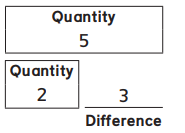
Pablo has 3 more pennies than Mary.
Solve. Use the diagrams to help you. Then write a number model to match.
Question 1.
Bart has 12 pennies. Perry has 8 pennies.
Who has more pennies? _________
How many more? _________ pennies
Number model: _________
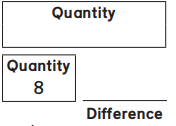
Answer:
Difference:

Bart has more pennies.
Bart has 4 or Four pennies more than Perry .
Number model: = 12 – 8 = 4 or four.
Explanation:
Number of pennies Bart has = 12 or Twelve.
Number of pennies Perry has = 8 or Eight.
Difference:
Number of pennies Bart has – Number of pennies Perry has
= 12 – 8
= 4 or four.
Question 3.
Tricia has 3 pennies. Martha has 10 pennies.
Who has more pennies? _________
How many more? _________ pennies
Number model: _________
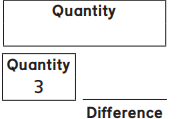
Answer:
Difference:

Martha has more pennies.
Martha has 7 or Seven more pennies than Tricia.
Number model: 10 – 3 = 7 or Seven.
Explanation:
Number of pennies Tricia has = 3 or Three.
Number of pennies Martha has = 10 or Ten.
Difference:
Number of pennies Martha has -Number of pennies Tricia has
= 10 – 3
= 7 or Seven.
Practice
Question 3.
How many pillows are in your home? _________ pillows
Answer:
There are 7 or Seven pillows in my home.
Explanation:
Number of pillows in my home = 7 or Seven.
Everyday Mathematics Grade 1 Home Link 5.11 Answers
Two-Digit Addition and Subtraction
Family Note
Today your child solved addition and subtraction number stories about animal weights. For the problems below, encourage your child to explain different methods he or she could use to solve the number stories (such as using a number line or number grid).
Add or subtract to solve the animal number stories.
Question 1.
How much taller is a peacock (60 in.) than an owl (20 in.)?

_________ in.
Number model: _________ – _________ = _________
Answer:
Peacock is 40 inches more taller than an owl.
Number model: 60 inches – 20 inches = 40 inches.
Explanation:
 .
.
Height of peacock = 60 inches
Height of owl = 20 inches.
Difference:
Height of peacock – Height of owl
= 60 inches – 20 inches
= 40 inches.
Question 2.
How long would the sun bear (54 in.) and parrot (31 in.) be if they lay nose to nose?

_________ in.
Number model: _________ + _________ = _________
Answer:
85 inches long the sun bear and the parrot will be if they lay nose to nose.
Number model: 54 inches + 31 inches = 85 inches.
Explanation:
Length of the sun bear = 54 inches.
Length of the parrot = 31 inches.
Sum:
Length of the sun bear + Length of the parrot
= 54 inches + 31 inches
= 85 inches.
Question 3.
How much do a beaver (56 lb) and a fox (14 lb) weigh all together?

_________ lb
Number model: _________ + _________ = _________
Answer:
Total weight of them all together = 80 lb.
Number model: __56 lb_______ + ___14 lb ______ = ___80 lb ______.
Explanation:
Weight of a beaver = 56 lb.
Weight of a fox = 14 lb.
Sum:
Total weight of them all together = Weight of a beaver + Weight of a fox
= 56 lb + 14 lb
= 80 lb.
Practice
Question 4.
True or False? 7 > 4 + 3 __________
Answer:
7 > 4 + 3 _____False____.
Explanation:
True or False
7 > 4 + 3
=> 7 > 7
Everyday Math Grade 1 Home Link 5.12 Answer Key
Using Tools
Family Note
Today your child used a variety of tools to add. Choosing helpful tools and knowing how to use them effectively are important skills in problem solving.
Throughout the year, when you see your child using tools such as pennies or a number line, encourage him or her to describe how the tool is helpful.
Ask someone at home to tell you about three tools they use at home or at work. Write the tools here.
Question 1.
_____________
Answer:
My mother said she uses pennies while doing shopping for groceries, clothing, transport etc.
Explanation:
I said my mother what tools she uses in home or at work. My mother said she uses pennies while doing shopping for groceries, clothing, transport etc.
Question 2.
______________
Answer:
My grandfather said he uses number line to measure the clothes length while stitching the clothes.
Explanation:
I have asked my grandfather what are the tools which he uses at home or office. My grandfather said he uses number line to measure the clothes length while stitching the clothes.
Question 3.
______________
Answer:
My elder brother said he uses measurement kit to draw diagrams in his school assignments.
Explanation:
I have asked my elder brother what are the tools which he uses at home or school. My elder brother said he uses measurement kit to draw diagrams in his school assignments.
Write three tools that you use in math class.
Question 4.
______________
Answer:
First tool : Scissors and rulers.
Explanation:
First tool that I use in math class:
Scissors and rulers.
Question 5.
______________
Answer:
Second tool : Compass and protractor.
Explanation:
Second tool that I use in math class:
Compass and protractor.
Question 6.
______________
Answer:
Third tool : A graphing calculator.
Explanation:
Third tool that I use in math class:
A graphing calculator.
Tell someone at home how you use one of the tools.
Practice
Question 7.
Solve.
13 – ______ = 9
14 – ______ = 8
16 – ______ = 7
Answer:
13 – __4____ = 9.
14 – __6____ = 8.
16 – __9____ = 7.
Explanation:
13 – ______ = 9
=> 13 – ?? = 9
=> 13 – 9 = ??
=> 4 or Four = ??.
14 – ______ = 8
=> 14 – ?? = 8
=> 14 – 8 = ??
=> 6 or Six = ??
16 – ______ = 7
=> 16 – ?? = 7
=? 16 – 7 = ??
=> 9 or Nine = ??